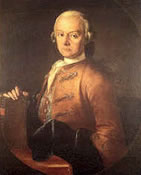Leopold MOZART (1719 – 1787)
The Austrian violonist/composer and father of Wolfgang Amadeus Mozart, LEOPOLD MOZART, is best known for his violin method of 1756. Published in the same year as Wolfgang’s birth, Leopold Mozart’s Comprehensive Violin Method was an important work of German music theory and violin pedagogy making its 37-year-old author famous throughout Europe. His method was similar to Geminiani’s earlier treatise, but included more advanced bowings. Leopold Mozart advocated faster bow speed for greater volume and better tone. His book was translated into French and Dutch during his lifetime.
for his violin method of 1756. Published in the same year as Wolfgang’s birth, Leopold Mozart’s Comprehensive Violin Method was an important work of German music theory and violin pedagogy making its 37-year-old author famous throughout Europe. His method was similar to Geminiani’s earlier treatise, but included more advanced bowings. Leopold Mozart advocated faster bow speed for greater volume and better tone. His book was translated into French and Dutch during his lifetime.
Leopold Mozart studied philosophy and law but was expelled from Benedictine University in Salzburg, Austria for poor attendance. He then became a composer and violonist, obtaining a post in 1743 as fourth violonist in the court orchetra. He was made violin teacher to the choirboys of the cathedral in the next year. In 1757, he was appointed composer to the court and chamber, the next year he advanced to the post of second violonist in the court orchestra, in 1763 to deputy Kapellmeister (conductor and leader).
Leopold Mozart married Anna Maria Pertl in 1747. Of their seven children, only two (Maria Anna and Wolfgang Amadeus) survived to adulthood.
The year 1760 was the high point of Leopold Mozart’s creative life. He seems to have composed rarely after 1762. The miracle which God let be born in Salzburg, his son Wofgang, changed Leopold’s life.
This second period in Leopold Mozart’s life can be understood only in its relation to Wolfgang’s. Leopold gave up his artistic life to devote himself to his son. He played an important role as proof reader and sometimes copyist for Wolfgang. The elder Mozart functioned as Wolfgang’s teacher, private secretary and travel organizer.
Leopold Mozart’s most significant works as a composer are his Sacrament Litany in D (1762), his three piano sonatas and his numerous and splendid symphonies. The Symphony Nr. 5 in F is especially original.

